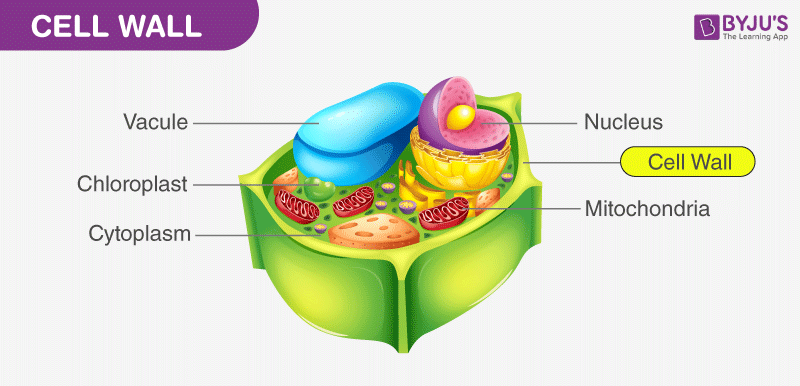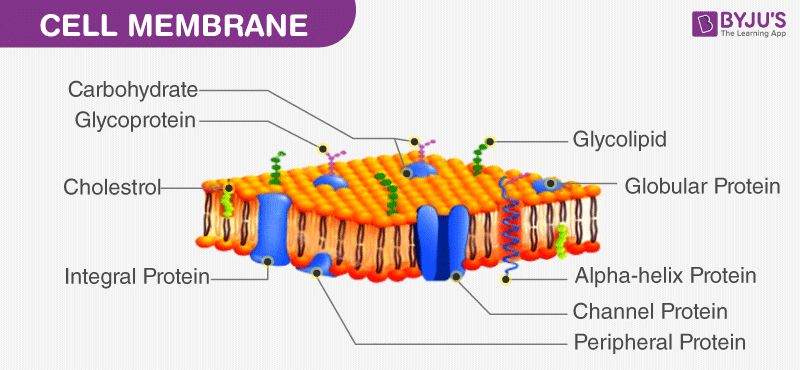A cell is the structural and functional working unit of life and also been described as building blocks and fundamental unit of an organism. The term cell was coined by an English scientist Robert Hooke in the year 1665. The shape and size of the cells vary according to their functions and compositions. There are different types of cells and can be differentiated based on the presence and absence of few cell organelles.
Table of Contents
- Cell Wall
- Cell Membrane
- Difference between Cell Wall and Cell Membrane
- Conclusion
- Important Questions for Cell Wall and Cell Membrane
Cell Wall

The cell wall is present only in plants, fungi and bacteria. The image above represents a plant cell wall
The cell wall is the outermost covering of plant cells. It is present outside the cell membrane and is tough, flexible and sometimes rigid in its texture. It is mainly composed of cellulose, long fibres of carbohydrates including hemicellulose, lignin and pectin.
The main functions of the cell wall are:
-
Protecting the cell against physical damage and invading pathogens.
-
Regulates and controls the direction of cell growth.
-
Providing the strength, structural support and maintaining the shape of the cell.
-
Functions as a storage unit by storing carbohydrates for use in plant growth, especially in seeds.
-
It allows entry of smaller molecules through it freely.
Explore More: Plant cell

Cell Membrane is present in all organisms including plants
The cell membrane is also known as the plasma membrane. It is the outermost covering of animal cells. It is a semi-permeable membrane composed of lipids and proteins. The main functions of the cell membrane include:
-
Protecting the integrity of the interior cell.
-
Providing support and maintaining the shape of the cell.
-
Helps in regulating cell growth through the balance of endocytosis and exocytosis.
-
The cell membrane also plays an important role in cell signalling and communication.
-
It acts as a selectively permeable membrane by allowing the entry of only selected substances into the cell.
Also Read: Animal Cell
Difference between Cell Wall and Cell Membrane
One of the fundamental differences between the plasma membrane and the cell wall is in the type of organisms that they are found. The cell wall is present only in plants and the cell membrane is present in every living organism including plants.
| CELL WALL |
CELL MEMBRANE |
| Present only in plants and in some fungi, bacteria, algae. | Present in all types of cells, in humans, animals, plants, bacteria, etc. |
| It is the outermost part of the plant cell | It is the outermost covering the animal cells |
| It is made up of pectin, chitin, lignin, glycoproteins, glycolipids, sugar, and cellulose. | It is a lipid bilayer. And is composed of lipoproteins and carbohydrates. |
| The cell wall is 0.1 μm to several μm in thickness | The cell membrane is 7.5–10 nm in thickness |
| It is the thick and rigid structure with a fixed shape. | It is a thin and delicate structure. It is flexible to change the shape as needed. |
| It protects the cell from the external environment. | It protects and maintains the internal environment of the cell. |
| The cell wall is metabolically inactive | The cell membrane is metabolically active. |
| The cell wall grows in thickness over time. Further, it occupies the whole cell in the plant as the cell ages and dies. | It is of the same thickness for the lifetime of the organism. |
| The cell wall is fully permeable to smaller molecules with the size of 30-60 kDa. | The membrane is selectively permeable and controls the movement of the substance into and outside the cell. |
| Functions include protection from the external environment. | Functions include permeability, signal reception, motility conduction, cell division, sexual reproduction, etc. |
Also Read: Difference Between Plant cell and Animal cell
Conclusion
The cell wall and cell membrane are two organelles that are an important part of living organisms. However, the former is found only in plants, fungi and in some bacteria. Traditionally, a cell well is defined as the layer of polysaccharides that exists outside the plasma membrane. It is rigid and serves structural and supportive functions. On the other hand, the cell wall in fungi is made from another material called chitin, which is also found in the exoskeletons of arthropods.
The cell membrane is present in all living organisms, including plants. It is the outermost layer of the cell in animals and encloses other cellular organelles within. Unlike the cell wall, the cell membrane is flexible and its shape can be changed as needed. Also, it is metabolically active and has selective permeability.
Important Questions for Cell Wall and Cell Membrane
1. What is the main function of the cell wall?
The cell wall is the outermost layer in a plant cell. It provides structural support and rigidity for the plant body.
2. What is the function of the cell membrane?
Unlike the cell wall, the cell membrane is present in all living organisms, including plants. The main role of the cell membrane is to provide protection to the cell from its surroundings.
3. Are cell walls and cell membranes the same thing?
Cell walls are distinctly different from cell membranes. For instance, the cell wall is present only in plants, fungi and some bacteria. The cell membrane, on the other hand, is present in all living organisms including plants.
4. What is the role of the plasma membrane?
The cell membrane is also called the plasma membrane. It provides protection for the cell and its cellular components from the external environment. It is selectively permeable and regulates the movement of molecules in and out of the cell.
5. What is the primary component of the cell wall?
The primary component of the cell wall varies with different organisms. In the plant cells, cellulose is the primary component of the cell wall, in bacteria the primary component of the cell wall is peptidoglycan and in fungi the primary component of the cell wall is chitin.
Explore more information about the cell wall and cell membrane or any other topic by registering at BYJU’S.
Further Reading:



Nice
Good ?
but, what do the cell wall and cell membrane have in common??
i see a whole bunch of splitting them up stating the difference, but what do they have in common?? pls answer.
It is very easy to read, it gives more knowledge for me about cell
How is an organ different from a tissue?
Tissue is a group of similar cells, which perform a specific function whereas an organ constitutes various tissues working together and organised in specific proportion and pattern. Check here for more details https://byjus.com/biology/animal-tissue-types/
very useful
This is very helpful. Thanks
productive